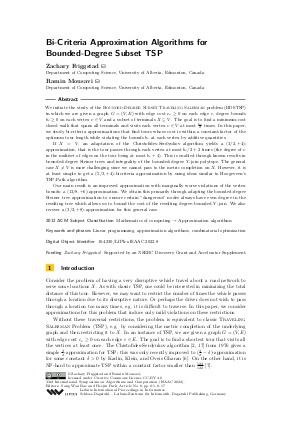Bi-Criteria Approximation Algorithms for Bounded-Degree Subset TSP
Authors Zachary Friggstad, Ramin Mousavi
-
Part of:
Volume:
33rd International Symposium on Algorithms and Computation (ISAAC 2022)
Part of: Series: Leibniz International Proceedings in Informatics (LIPIcs)
Part of: Conference: International Symposium on Algorithms and Computation (ISAAC) - License:
 Creative Commons Attribution 4.0 International license
Creative Commons Attribution 4.0 International license
- Publication Date: 2022-12-14
File

PDF
LIPIcs.ISAAC.2022.8.pdf
- Filesize: 0.73 MB
- 17 pages
Document Identifiers
Subject Classification
ACM Subject Classification
- Mathematics of computing → Approximation algorithms
Keywords
- Linear programming
- approximation algorithms
- combinatorial optimization
Metrics
- Access Statistics
-
Total Accesses (updated on a weekly basis)
0Document
0Metadata
Abstract
We initiate the study of the Bounded-Degree Subset Traveling Salesman problem (BDSTSP) in which we are given a graph G = (V,E) with edge cost c_e ≥ 0 on each edge e, degree bounds b_v ≥ 0 on each vertex v ∈ V and a subset of terminals X ⊆ V. The goal is to find a minimum-cost closed walk that spans all terminals and visits each vertex v ∈ V at most b_v/2 times. In this paper, we study bi-criteria approximations that find tours whose cost is within a constant-factor of the optimum tour length while violating the bounds b_v at each vertex by additive quantities. If X = V, an adaptation of the Christofides-Serdyukov algorithm yields a (3/2, +4)-approximation, that is the tour passes through each vertex at most b_v/2+2 times (the degree of v in the multiset of edges on the tour being at most b_v + 4). This is enabled through known results in bounded-degree Steiner trees and integrality of the bounded-degree Y-join polytope. The general case X ≠ V is more challenging since we cannot pass to the metric completion on X. However, it is at least simple to get a (5/3, +4)-bicriteria approximation by using ideas similar to Hoogeveen’s TSP-Path algorithm. Our main result is an improved approximation with marginally worse violations of the vertex bounds: a (13/8, +6)-approximation. We obtain this primarily through adapting the bounded-degree Steiner tree approximation to ensure certain "dangerous" nodes always have even degree in the resulting tree which allows us to bound the cost of the resulting degree-bounded Y-join. We also recover a (3/2, +8)-approximation for this general case.
Cite As Get BibTex
Zachary Friggstad and Ramin Mousavi. Bi-Criteria Approximation Algorithms for Bounded-Degree Subset TSP. In 33rd International Symposium on Algorithms and Computation (ISAAC 2022). Leibniz International Proceedings in Informatics (LIPIcs), Volume 248, pp. 8:1-8:17, Schloss Dagstuhl – Leibniz-Zentrum für Informatik (2022)
https://doi.org/10.4230/LIPIcs.ISAAC.2022.8
BibTex
@InProceedings{friggstad_et_al:LIPIcs.ISAAC.2022.8,
author = {Friggstad, Zachary and Mousavi, Ramin},
title = {{Bi-Criteria Approximation Algorithms for Bounded-Degree Subset TSP}},
booktitle = {33rd International Symposium on Algorithms and Computation (ISAAC 2022)},
pages = {8:1--8:17},
series = {Leibniz International Proceedings in Informatics (LIPIcs)},
ISBN = {978-3-95977-258-7},
ISSN = {1868-8969},
year = {2022},
volume = {248},
editor = {Bae, Sang Won and Park, Heejin},
publisher = {Schloss Dagstuhl -- Leibniz-Zentrum f{\"u}r Informatik},
address = {Dagstuhl, Germany},
URL = {https://drops.dagstuhl.de/entities/document/10.4230/LIPIcs.ISAAC.2022.8},
URN = {urn:nbn:de:0030-drops-172932},
doi = {10.4230/LIPIcs.ISAAC.2022.8},
annote = {Keywords: Linear programming, approximation algorithms, combinatorial optimization}
}
Author Details
Funding
- Friggstad, Zachary: Supported by an NSERC Discovery Grant and Accelerator Supplement.
References
-
Hyung-Chan An, Robert Kleinberg, and David B Shmoys. Improving christofides' algorithm for the st path tsp. Journal of the ACM (JACM), 62(5):1-28, 2015.

-
Nicos Christofides. Worst-case analysis of a new heuristic for the travelling salesman problem. Technical report, Carnegie-Mellon Univ Pittsburgh Pa Management Sciences Research Group, 1976.

-
András Frank. On a theorem of mader. Discret. Math., 101:49-57, 1992.

-
Takuro Fukunaga, Zeev Nutov, and R Ravi. Iterative rounding approximation algorithms for degree-bounded node-connectivity network design. SIAM Journal on Computing, 44(5):1202-1229, 2015.

-
Michel X Goemans. Minimum bounded degree spanning trees. In 2006 47th Annual IEEE Symposium on Foundations of Computer Science (FOCS'06), pages 273-282. IEEE, 2006.

-
Anna R. Karlin, Nathan Klein, and Shayan Oveis Gharan. A (slightly) improved approximation algorithm for metric tsp. Proceedings of the 53rd Annual ACM SIGACT Symposium on Theory of Computing, 2021.

-
Marek Karpinski, Michael Lampis, and Richard Schmied. New inapproximability bounds for tsp. Journal of Computer and System Sciences, 81(8):1665-1677, 2015.

-
Rohit Khandekar, Guy Kortsarz, and Zeev Nutov. On some network design problems with degree constraints. Journal of Computer and System Sciences, 79(5):725-736, 2013.

-
Lap Chi Lau, Joseph Naor, Mohammad R Salavatipour, and Mohit Singh. Survivable network design with degree or order constraints. SIAM Journal on Computing, 39(3):1062-1087, 2009.

-
Lap Chi Lau, Ramamoorthi Ravi, and Mohit Singh. Iterative methods in combinatorial optimization, volume 46. Cambridge University Press, 2011.

-
Lap Chi Lau and Mohit Singh. Additive approximation for bounded degree survivable network design. SIAM Journal on Computing, 42(6):2217-2242, 2013.

-
Lap Chi Lau and Hong Zhou. A unified algorithm for degree bounded survivable network design. Mathematical Programming, 154(1):515-532, 2015.

-
Anand Louis and Nisheeth K Vishnoi. Improved algorithm for degree bounded survivable network design problem. In Scandinavian Workshop on Algorithm Theory, pages 408-419. Springer, 2010.

-
Wolfgang Mader. A reduction method for edge-connectivity in graphs. Annals of discrete mathematics, 3:145-164, 1978.

-
Ian Post and Chaitanya Swamy. Linear programming-based approximation algorithms for multi-vehicle minimum latency problems. In Proceedings of the Twenty-Sixth Annual ACM-SIAM Symposium on Discrete Algorithms, pages 512-531. SIAM, 2014.

-
Alexander Schrijver. Combinatorial optimization: polyhedra and efficiency, volume 24. Springer Science & Business Media, 2003.

-
AI Serdyukov. O nekotorykh ekstremal’nykh obkhodakh v grafakh. Upravlyayemyye sistemy, 17:76-79, 1978.

-
Mohit Singh and Lap Chi Lau. Approximating minimum bounded degree spanning trees to within one of optimal. Journal of the ACM (JACM), 62(1):1-19, 2015.

-
Laurence A Wolsey. Heuristic analysis, linear programming and branch and bound. In Combinatorial Optimization II, pages 121-134. Springer, 1980.

